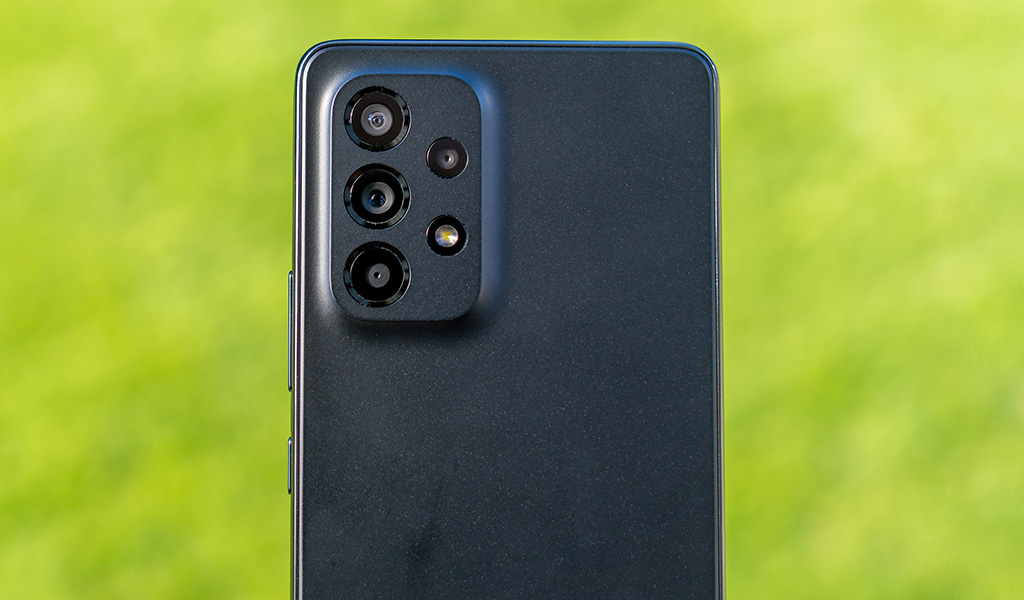 One could argue most people just want a smartphone that does the basics well, and the Samsung Galaxy A53 is the kind of phone making that case. Mid-range phones have seen bigger strides—at least in my opinion—than flagships have over the last few years.
One could argue most people just want a smartphone that does the basics well, and the Samsung Galaxy A53 is the kind of phone making that case. Mid-range phones have seen bigger strides—at least in my opinion—than flagships have over the last few years.
A big reason why is because more of that flagship technology is trickling down to the mid-range. Samsung has been steadily doing it with its phones, and the results continue to get better for it. That also goes for the build quality and software performance, which form the backbone for what a device like this turns out to be.
Samsung Galaxy A53 specsDisplay: 6.5-inch 2400 x 1080 Super AMOLED display 20:9 aspect ratio with 405 pixels per inch |
Samsung Galaxy A53 design
Truth be told, Samsung didn’t change a whole lot on the spec sheet from the previous Galaxy A52. So many things are the same, though the numbers don’t tell the full story. For instance, the Exynos 1280 processor in the Galaxy A53 is a step up, as is the 5000mAh battery inside. Both make an impact because, despite a faster chip, battery life isn’t hurt because of it.
It’s also worth noting Samsung chose not to change much on the overall aesthetics. It did alter a few things, like the sides, which are flatter and made with a chrome finish. I’m not sure I liked the switch to chrome, as it takes mere seconds before it gets smudged. After a while, it also loses its lustre, though Samsung says it will retain its shimmer for a long while. We’ll see.
As I held this device, I started feeling like it was a redux situation. So much of it felt like the Galaxy A52, and that is by design. Samsung must think it has a good formula here, and why not, given the A52 was its best-selling phone globally in 2021. The nice polycarbonate matte finish is back, giving the phone a restrained, yet smart look that doesn’t really scream out its mid-range credentials. It is missing one key thing, and that’s the headphone jack.
The legacy here is otherwise very much intact. The screen size has been the same going back to 2020 with the Galaxy A51. So is the quad camera array, which returns from the A52 with exactly the same image sensors. Same with the 120Hz refresh rate to make navigation and gaming particularly smooth.
Not surprisingly, storage and memory shape up to be the same as well. My review unit had 128GB of storage and 6GB of RAM. The SIM card slot doubles as a microSD card slot to expand on the existing storage, in case you need more room.
Samsung Galaxy A53 screen display
Since Samsung uses the same display as the previous model did, screen brightness can be a factor. It does get sufficiently bright when outside in the sun, but I really had to crank it to max output to make it easier to see it. I would say, though, there is a slight improvement here over the Galaxy A52, which didn’t always hit the same max when I tested it.
Don’t get me wrong, the screen is one of the best you’ll look at on a mid-range device. It’s a vibrant panel that reminded me why devices like this are growing in popularity. The faster 120Hz refresh rate also gives it a smoothness I could appreciate as I used various apps on the phone. It’s also nice and responsive, with a reliable onscreen fingerprint scanner to add to the mix.
It is also enjoyable to play casual games or watch a show or movie on it. The screen may not have the resolution better Samsung panels have, but that’s fine. The visuals still look sharp and vibrant, and I imagine most would agree after spending some time gazing at the screen.
 Samsung Galaxy A53 performance and software
Samsung Galaxy A53 performance and software
There’s not much of a story to tell here, to be honest. The Galaxy A53 runs on Android 12 and Samsung’s One 4.1, a combination that suits this phone perfectly fine. If you’re expecting a phone to just work and do what it’s supposed to, that would be a good way to describe what the A53 does.
It’s that everyday workhorse that does the things you mostly do on your phone. Whether it’s streaming, messaging, browsing, social media and taking photos, the Galaxy A53 is up to the task. It performs these tasks in a serviceable way, meaning you kind of just do them and not really feel or notice that something’s off. As for gaming, for the most part, games will run fine on this phone. The more demanding the game, the more you might run into some lag, but generally, all should go well.
I can understand more demanding users may feel differently about the A53’s capability, but that’s not who this device is for. For example, if your daily routine consists of messaging people on different apps, streaming music or podcasts, and playing a game on a commute, you should have little trouble doing any of that. Just because you won’t have the fastest processor or the most advanced screen doesn’t really detract from all that.
One thing I didn’t like was that Samsung didn’t enable the Galaxy A53 to run on Wi-Fi 6. Mid-range or not, it should be able to connect to faster and better Wi-Fi connections. You may not notice it, especially if you don’t have a router running Wi-Fi 6, but if you do, it’s an annoying omission.
Samsung Galaxy A53 camera quality
Here’s the deal: the photos and video you take with the Galaxy A53 are going to largely mirror those shot with the previous Galaxy A52. Now, there are a couple of exceptions, and they do matter. One is low-light and night photos, which are better this time around. It’s Samsung’s software that does most of the work to make that happen, and it results in more consistency when you shoot in those conditions.
Regardless of whether it’s day or night, bright or dark, the camera has a tendency to ramp up exposure to try brightening a shot for more detail. The best way to offset that in a daytime shot is to slide down the exposure slider (the sun icon) just enough to get more contrast. You’ll notice this both outdoors and indoors, and so, adjusting the slider becomes a common theme when taking photos.
The main and ultra-wide cameras shoot well for a mid-range phone, whereas the macro and depth cameras leave plenty to be desired. I understand why Samsung includes them in the Galaxy A53, I just don’t get why it doesn’t apply a higher level of improvement to them relative to the other cameras.
Many of Samsung’s shooting modes apply to the camera array, including the Pro modes for photos and video. Fun Mode is back using Lenses filters from Snapchat, plus full-body tracking to share with others. If you’re into this sort of thing, you may find it fun (no pun intended) to play around with.
Samsung Galaxy A53 battery life
Going with a larger 5000mAh battery serves the Galaxy A53 really well because it just lasts that much longer per charge. Despite a faster processor, I had little trouble getting through a full day while using it. Not that I ever really ran into any issues when testing the A52, so this felt familiar to me.
Note that there is no wall charger in the box with the phone, though you do get the USB-C cable. That will be your only way to charge the Galaxy A53, as there is no wireless charging support here.
Final thoughts
Samsung did little to separate the Galaxy A53 from its predecessor. I believe this was intentional, for the simple reason that it has a winning formula with its Galaxy A series that it doesn’t need to mess with. If you want a reliable phone that costs much less than flagship alternatives, yet you still get a lot of the benefits from a software perspective, it’s hard to argue against the value proposition. Throw in excellent battery life, and I think this is the kind of phone that will satisfy most people.
The Samsung Galaxy A53 is available now at bestbuy.ca.













